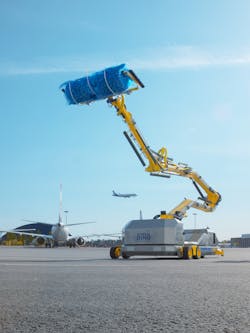How Aircraft Cleaning Robots have Opened a New Scene
An aviation industry segment that sometimes is viewed as rather niche – aircraft exterior cleaning – has been gaining interest in recent years. With now a bigger spotlight on a few of the less-sustainable aviation processes, several aircraft operators are looking into modifying some of the practices to become more eco-friendly.
While aircraft exterior cleaning might not be the first thing that comes to mind when thinking of sustainability in aviation, it still is one of the key players in contributing to wasteful processes. Traditionally, commercial aircraft are cleaned by using highly pressurized water, a technique that uses anywhere between 9,500 to 11,300 liters of water to clean one aircraft. Aviator Robotics AB CEO Jan Brunstedt, the creator of Nordic Dino aircraft exterior cleaning robot, explains that the exterior cleaning practices have changed dramatically over the last few decades.
“The mid-2000 was the time when aircraft exterior cleaning was done in hangars for the purpose of preserving image – that was the norm. No one really put much mind into reducing water usage two decades ago. Even now, there are airlines that still stick to traditional washing. Every other night ground staff gather to wash aircraft – which requires a lot of water and manpower on top of everything else.”
Nowadays, aircraft exterior cleaning for is far more refined. With the increasing cost of fuel airline operators can achieve significant cost savings across their fleets by implementing regular aircraft exterior cleaning with the Nordic Dino robots. Companies that provide these services have worked on advancing their technologies to comply with environmental protection regulations. Brunstedt notes that one of such advancements is automatization. Automatic exterior cleaning robots have opened new ways of reducing water usage and bringing sustainable practices into focus. According to Brunstedt, more than 30% of water is saved when compared to the traditional methods.
Current solutions in the market, like Nordic Dino, have been in the lead with innovative approaches. First launched more than four decades ago, the company is only among a few in Europe that offers automatized exterior cleaning, adapted to work with a wide range of aircraft body types. Alongside that, the robots can be equipped with electric motors, further minimizing the environmental impact.
“Roboticized solutions have truly changed the game for the aviation industry – in the past, there was a huge number of processes that needed to be automatized – and exterior cleaning was one of them,” adds Brunstedt. “Some still think that aircraft are washed only by hand, and while a good number of MROs and aircraft cleaning companies do that, exterior cleaning robots are confidently making their way into these processes, bringing more sustainability with them.”
